Plant Tissues and Organs | COMPLETE NOTES
Plant Tissue Types and Organization
• Understanding the level of organisation of living organisms.
• Cell: Basic unit of life.
• Tissue: Group of similar specialized cells performing specific functions.
• Organ: Group of different tissues working together.
• Organ System: Group of organs working together.
• Organism: Whole body of a plant.
• Differentiation: Specialized cells specialize and group together to form tissues.
• Types of Plant Tissues: Function depends on the location in the plant.
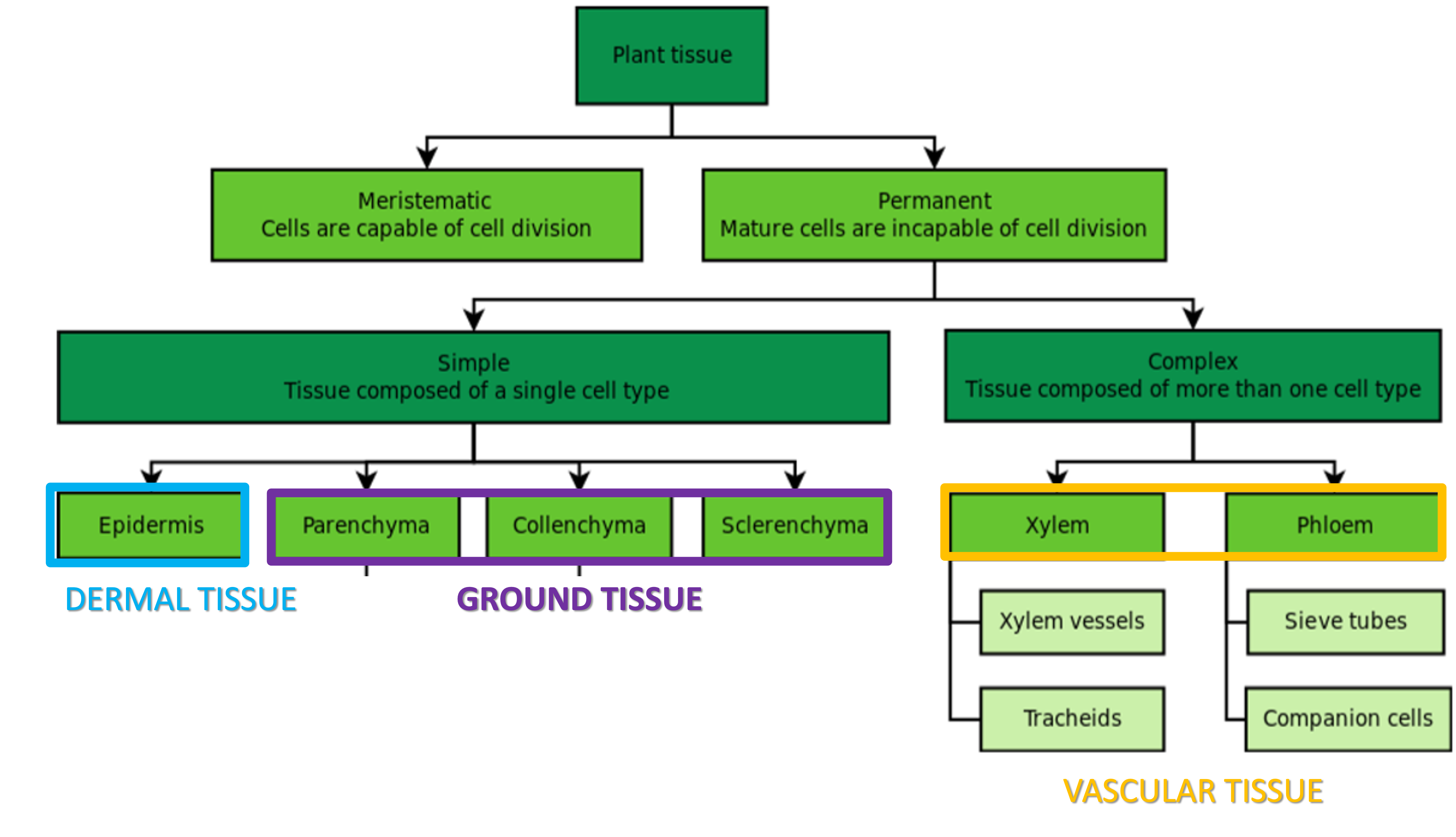
Understanding Plant Tissues: Meristematic Tissue and Apical Meristem
Meristematic Tissue Types
• Actively dividing tissue in plants.
• Two types: Apical and Lateral.
Apical Meristem
• Groups of cells near roots and stem tips.
• Responsible for growth in length by mitosis.
• Basic structure: small cells, thin walls, absent vacuums, cube-shaped cells, large, prominent nuclei.
• Function: Primary growth of plants.
Lateral Meristem
• Found between xylem and phloem in dicotyledonous plants.
• Basic structure: flatter, slightly elongated cells with thicker wall.
• Function: Secondary growth in plants.
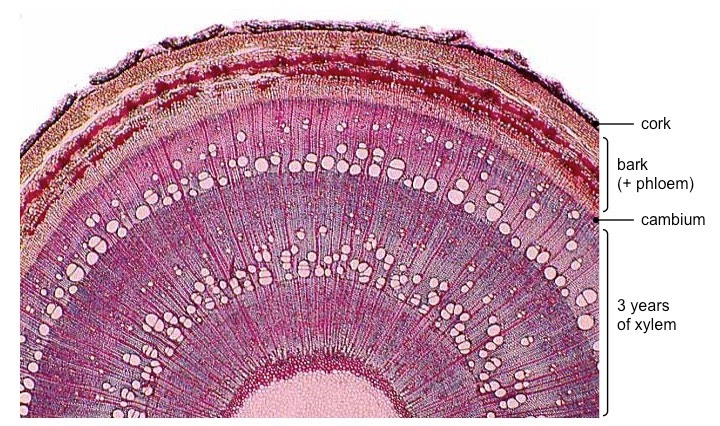
Vascular Tissue Structure and Function
Vascular Tissue Types: Xylem and Phloem
• Xylem: Contains no living material and is considered dead tissue.
• Phloem: Composed of living cells that do not contain thickened cell walls.
• Xylem vessels: Consist of elongated cells connected end to end.
• Tracheids: Elongated cells with tapered ends.
• Xylem vessels transport water and minerals from roots to the plant.
• Phloem tissues: mainly consist of sieve tubes and companion cells.
Functions of Xylem:
• Transports water and minerals from roots to the plant.
• Serves as strengthening and support tissue for the plant.
Functions of Phloem:
• Transports produced organic nutrients from leaves to the rest of the plant.
Plant Tissue and Epidermal Tissue
• Plant tissue includes permanent tissue, including epidermal tissue, ground tissue, and vascular tissue.
• Epidermal cells are brick-shaped, transparent, and have no chloroplasts. They are covered by a waxy layer, the cuticle, and can be modified into root hairs or guard cells.
• Specialised epidermal cells, such as root hair cells and guard cells, have specific functions.
• Root hairs increase the absorption surface for water and mineral salts, allow gas exchange, take up CO2 needed for photosynthesis, release O2, and contain chloroplasts for photosynthesis.
• Guard cells have unevenly thickened walls, preventing water absorption through the epidermal layer of roots.
• The epidermis protects the plant from injury and dehydration, prevents moisture loss through leaves and stems, and is transparent for photosynthesis.
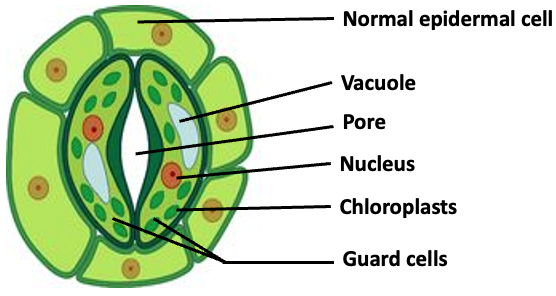
Understanding Plant Tissues: Parenchyma, Sclerenchyma, and Collenchyma
Parenchyma:
• Most abundant plant tissue, containing chloroplasts.
• Forms both types of mesophyll tissue in leaves.
• Features large, thin cell walls, large intercellular spaces, and large vacuoles.
• Functions include food and water storage, carbohydrate production, gaseous exchange, and rigidity due to turgor pressure.
Schlerenchyma:
• Found in leaves, stems, and fruit.
• Cell walls are evenly thickened with lignin, each cell has a small lumen.
• Two types of cells: Sclereids (round cells) and Fibres (elongated fibers).
• Functions as a strengthening tissue providing rigid mechanical support to the plant.
Collenchyma:
• Usually occurs in young, growing herbaceous stems.
• Cell walls are unevenly thickened with cellulose, most thickening occurs in the corners of the cell walls.
• Functions as a strengthening tissue providing flexible mechanical support to some stems and leaves.
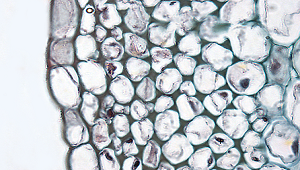
Introduction to Plant Organisms
• Classification of plants as monocotyledons or dicotyledons based on specific plant structures.
• Different plant organs (roots, stems, leaves, flowers) perform specific functions.
• Dicotyledons leaf is an example of an organ.
• Leaves trap sunlight for photosynthesis, allow gaseous exchange for photosynthesis, respiration, and transpiration.
• They also transport water and food (organic molecules).
• Different types of leaves and their external structure are discussed.
Dicotyledons Leaf Structure and Photosynthesis Adaptations
• Epidermal cells are transparent for light penetration.
• Vascular bundles distribute water for photosynthesis.
• Stomata on leaf surface facilitate gas exchange.
• Palisade parenchyma cells located at top for maximum light absorption.
• Elongated cells allow deeper sunlight penetration.
• Densely arranged cells with few intercellular spaces for maximum sunlight exposure.
• Spongy parenchyma cells loosely arranged for gas exchange and water osmosis.
• Xylem transports water and dissolved minerals to mesophilic cells.
• Phloem transports manufactured nutrients away from the leaf.
Structure of a dicotyledons leaf
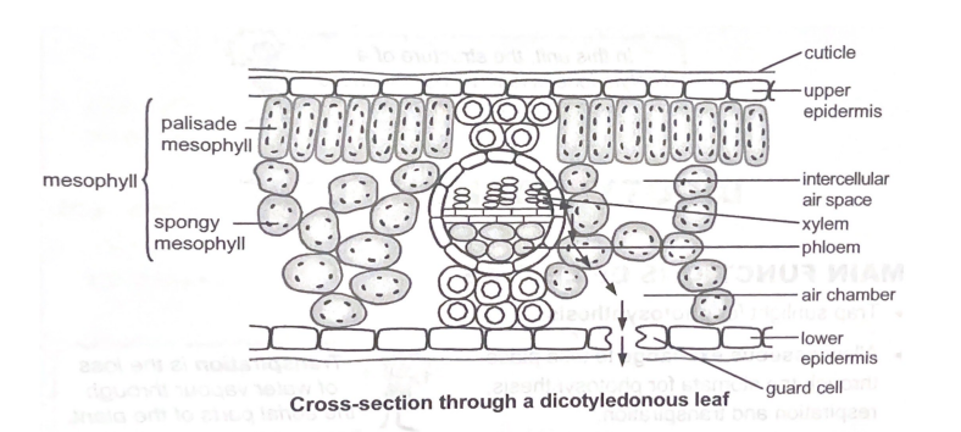
Dicotyledons Leaf: Specialised Tissues and Cells
Epidermis:
• Covers upper and lower surfaces of the leaf.
• Protects underlying tissue and is transparent for sunlight.
• Covered by a cuticle to prevent water loss.
• Lower epidermal cells contain stomata for gaseous exchange.
Mesophyll:
• Two types: Palisade and Spongy.
• Palisade mesophyll cells are elongated, thin-walled parenchyma cells under the upper epidermis.
• Spongy mesophyll cells are loosely packed, contain large intercellular spaces, and contain fewer chloroplasts for photosynthesis.
Vascular Bundles/Veins:
• Consist of xylem & phloem continuous with the root and stem xylem.
• Water absorbed from the soil and transported via the root and stem xylem to the leaf xylem moves by osmosis until it reaches the mesophyll cells for photosynthesis.